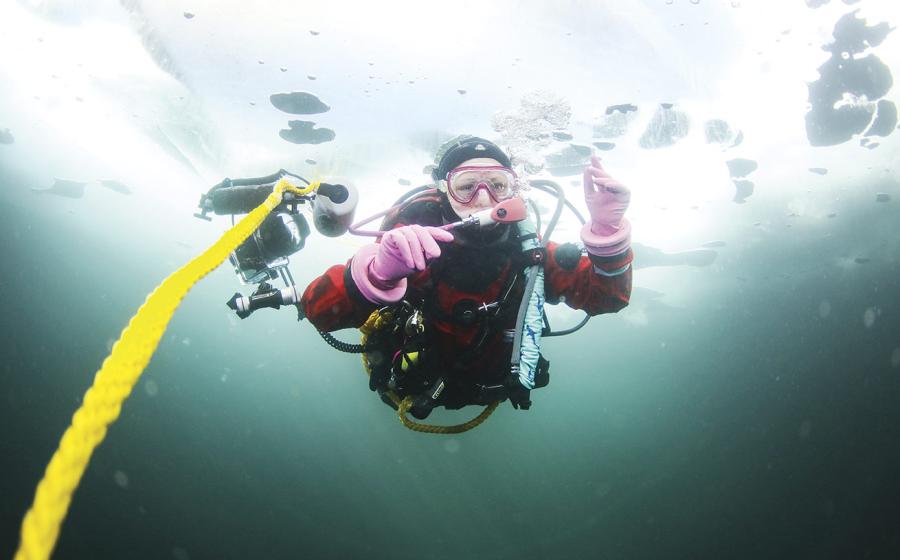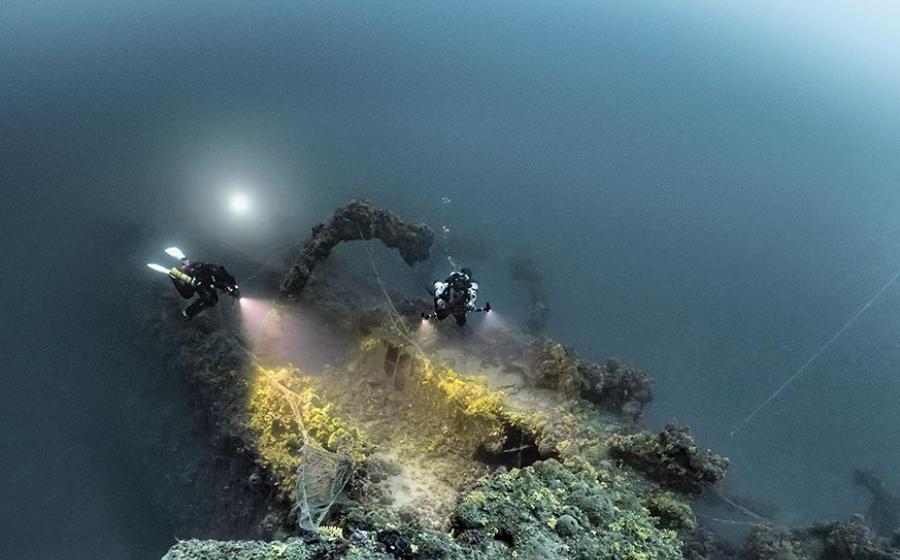Cool Catalina
After latching the final clip on my BC and checking my gear, I struggle to stand. The 35 pounds of lead riding on my waist will counter the buoyancy of my drysuit while underwater, but standing on deck it is just damn heavy. The boat's rear platform serves as my launch pad, and within minutes I am surrounded by the reason that I am a diehard Catalina dive fan - the enchanting kelp forest. Shafts of light penetrating the auburn canopy usher me downward. Caribbean waters boast warmth and visibility, the Red Sea is blanketed with a kaleidoscope of corals, but to me these beauties can't compare to the magic of California's towering underwater forest. Giant kelp, or Macrocystis pyrifera, commands the scene here, providing refuge to thousands of species that teem throughout the translucent fronds. In the definitive book, California Reefs, Chuck Davis reports that a single kelp plant can harbor more than 500,000 individual sea creatures. Maneuvering through the floating forest, I can feel the durability of the kelp that enables it to serve as a protective coastal barrier during harsh storms. Flamboyant garibaldis, California's state fish, seem to know they are legally protected as they fearlessly approach and peer into my mask. I can see the silhouette of a small harbor seal prancing on the outskirts of the forest. These pinnipeds often come very close, but this one seems timid and remains at a distance. I roll over onto my back and hover just above the rocky seabed. Forty feet below the surface, I lie still for the bulk of my dive, gazing up at the kelp formations, dancing light shafts and migrating schools of slender se-oritas. I am soon surrounded by several fish that seem confused by my stillness. The visibility glistens for about 80 feet. Other than periodic breath sounds, all is still, quiet and tranquil, and I continue to enjoy the gentle light show produced by the diaphanous kelp. A sharp tug on my fin shatters my underwater meditation. I right myself just in time to see my "timid" harbor seal friend duck out of sight. A WORLD AWAY FROM LOS ANGELES. Catalina is the southernmost of the eight California Channel Islands. Although it lies only about 20 miles from Los Angeles, visitors taking the short jaunt from the mainland will find themselves in another world. The Channel Islands are protected under California law, so building and other forms of development are prohibited on most of the islands. Although mostly virgin, Catalina Island supports the small community of Avalon that contains a sprinkling of charming hotels and restaurants catering to the island's visitors. One of the island's more popular dive sites is off Casino Point. The casino, an impressive building and a Catalina icon, was never actually used for gambling. Currently, it hosts a variety of community events such as the jazz festival and theater productions. A new set of steps provides easy entry to the Casino Point Underwater Reserve, which is designated as a no-take zone where no boats are allowed. On my last trip to the island, I clung to the hand railing while carefully descending the stairs. From there, I flopped unceremoniously into the glassy water. The structure of a kelp reef is analogous to a rain forest. The rain forest's thick canopy supports most of the ecosystem's life. Similarly, the slender kelp fronds provide housing opportunities for many small animals. This great habitat for fish is also a pain in the neck for surface-swimming divers. Blades of kelp routinely wrap around gear and slow down progress. Savvy divers drop under the canopy as soon as possible. Mid-water topography is more diver-friendly. Kelp blades are dispersed, buoyed intermittently by small bladders called pneumatocysts. These gas-filled sacs keep the blades floating near the surface's life-giving sunlight. Some of the older, more weathered kelp fronds are encrusted with white bryozoans, epiphytic plants that grow on kelp leaves. Over time, the leaves become so loaded with bryozoans that they sink to the ocean floor and die. Kelp beds grow best on rocky bottoms. The more irregular the terrain, the more marine life that can be supported. The enormous kelp plants are affixed to the rocks by root-like structures called "hold fasts." This lower level of the kelp forest is where I spent the majority of my Casino Point dive. It is easy to navigate through the well-spaced kelp, and the bottom is filled with life. I saw several small fish schools patrolling the waters, including olive rockfish, perch and mackerel. AN ADDICTIVE ISLAND Back on shore, I peeled off my suit and joined several divers who were swapping stories and sharing a bag of corn chips. Two members of the group, Christo and Myriam, were visiting Catalina for their honeymoon. "Until today we had been diving the island from a small private rental boat," says Myriam, a petite woman with a French accent. "It was inexpensive, and we came and went as we wanted. I really liked the extra freedom. "When we weren't diving, we spent all our time relaxing," she added. "And shopping," Christo piped in. "There are so many cute shops. I love it," agreed Myriam. "Dive, relax, eat and shop and then do it all again. That is my idea of a perfect vacation." Christo says he has enjoyed his first experience diving in cold water. Another member of the group, a young woman named Marin who is a graphics student at Cal State Long Beach, confides that this trip to Catalina was the first time she has ever dived. "I came out here to take the PADI Discover Scuba Diving experience, but I am getting certified as soon as I get back to school," she exclaimed. "As far as I am concerned, Catalina is addictive." I couldn't agree more.






